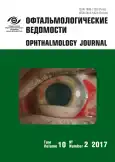Results of presbyopia correction with multifocal profile application on the cornea by photorefractive keratectomy in hyperopic patients
- Authors: Eskina E.N.1, Parshina V.A.1
-
Affiliations:
- Institute of professional development of the Federal Medical and Biological Agency
- Issue: Vol 10, No 2 (2017)
- Pages: 13-21
- Section: Articles
- URL: https://journals.rcsi.science/ov/article/view/6737
- DOI: https://doi.org/10.17816/OV10213-21
- ID: 6737
Cite item
Abstract
Aim. To compare the efficacy, safety, and predictability of simultaneous hyperopia and presbyopia correction using photorefractive keratectomy (PRK) with the application of a bi-aspheric multifocal profile on the cornea using PresbyMax software and hyperopia correction using LASIK.
Methods. Overall, 50 patients were divided into two groups: 25 patients (50 eyes) in group 1 underwent PRK with bi-aspheric multifocal profile application on the cornea using PresbyMax software for simultaneous hyperopia and presbyopia correction. Group 2 included 25 patients (50 eyes) who underwent LASIK with aspheric profile application on the cornea for hyperopia correction.
Results. One year after surgery in group 1, binocular distance uncorrected visual acuity (DUCVA) was 0.96 ± 0.16, near uncorrected visual acuity (NUCVA) was 0.77 ± 0.17, and intermediate uncorrected visual acuity (IUCVA) was 0.64 ± 0.15. Visual acuity loss of up to 0.2 was found in two eyes (4%). Target refraction in the dominant eye (emmetropia) was obtained in 72% of patients; in 28% of cases, a shift up to –0.75 D was observed. Target refraction in the non-dominant eye was found in 68% of patients, 12% of patients had a shift from the target refraction of –0.50 D, and 20% of patients of –0.75 D. Spherical aberration in the 6-mm zone was –0.22 ± 0.17 μm. One year after surgery in group 2, binocular DUCVA was 1.0 ± 0.10, NUCVA was – 0.37 ± 0.16, and IUCVA was – 0.43 ± 0.12. No monocular best corrected distance visual acuity loss was found. A myopic shift from the planned target (emmetropia) of –0.50 D was established in 4% of patients. Spherical aberration in the 6-mm zone was –0.10 ± 0.08 μm.
Conclusion. PRK with bi-aspheric multifocal profile application, unlike LASIK, not only achieves hyperopia correction but also improves near visual acuity in patients of presbyopic age.
Keywords
Full Text
##article.viewOnOriginalSite##About the authors
Erika N. Eskina
Institute of professional development of the Federal Medical and Biological Agency
Author for correspondence.
Email: erika.eskina@sfe.ru
MD, PhD, DMedSc, professor. Ophthalmology Department
Russian Federation, MoscowVictoria A. Parshina
Institute of professional development of the Federal Medical and Biological Agency
Email: vparshina@sfe.ru
MD, ophthalmologist, postgraduate researcher
Russian Federation, MoscowReferences
- Куренков В.В. Руководство по эксимерлазерной хирургии роговицы. – M., 2002. – С. 29–41. [Kurenkov VV. Rukovodstvo po jeksimerlazernoj hirurgii rogovicy. Moscow, 2002. P. 29-41. (In Russ.)]
- Эскина Э.Н. PresbyMAX — новейшая методика коррекции пресбиопии. Практическое применение эксимерного лазера Амарис Швинд // Новое в офтальмологии. – 2013. – № 1. – C. 48–53. [Jeskina JeN. PresbyMAX – novejshaja metodika korrekcii presbiopii. Prakticheskoe primenenie jeksimernogo lazera Amaris Shvind. Novoe v oftal’mologii. 2013;(1):48-53. (In Russ.)]
- Пекарский М. И., Эскина Э.Н. Патоморфологические аспекты воздействия эксимерного лазера на роговицу // Рефракционная хирургия и офтальмология. – 2001. – Т. 1. – № 2. – С. 42–48. [Pekarskij MI, Jeskina JeN. Patomorfologicheskie aspekty vozdejstvija jeksimernogo lazera na rogovicu. Refrakcionnaja hirurgija i oftal’mologija. 2001;1(2):42-48. (In Russ.)]
- Arba MS, Alió JL. Presbyopic correction on the cornea. EyeVis (Lond). 2014;(1):5.
- Baudu P, Penin F, Arba-Mosquera S. Unccorrected binocular performance after bi-aspheric ablation profile for presbyopic corneal treatment using AMARIS with PresbyMax module. Am J Ophtalmol. 2013;155(4):636-647. doi: 10.1016/j.ajo.2012.10.023.
- Iribarne Y, Juarez E, Arba-Mosquera S, et al. Bi-aspheric ablation profile for presbyopic hyperopic corneal treatments using AMARIS with PresbyMAX module: Multicentric Study in Spain. Journal of Emmetropia. 2012;(3):5-16.
- Garcia-Gonzalez M, Teus MA, Hernandez-Verdejo JL. Visual outcomes of LASIK-induced monovision in myopic patients with presbyopia. Ophthalmology. 2010;150. doi: 10.1016/j.ajo.2010.03.022.
- Gil-Cazorla R, Shah S, Naroo SA. A review of the surgical options for the correction of presbyopia. Br J Ophthalmology. 2016;100(1):62-70. doi: 10.1136/bjophthalmol-2015-306663.
- Habibollahi A, Hashemi H, Seyedian M, et al. One Year Outcomes of Photorefractive Keratectomy with the Application of Mitomycin-C in the Treatment of Mild to Moderate Hyperopia. Middle East Afr J Ophthalmol. 2015Oct-Dec;22(4):484-488. doi: 10.4103/0974-9233.167821.
- Plaza-Puche AB, Yebana P, Arba-Mosquera S, Alió JL. Three-Year Follow-up of Hyperopic LASIK Using a 500-Hz Excimer Laser System. J Refract Surg. 2015Oct;31(10):674-82. doi: 10.3928/1081597X-20150928-06.
- Sandoval HP, Donnenfeld ED, Kohnen T, et al. Modern laser in situ keratomileusisoutcomes. J Cataract Refract Surg. 2016 Aug;42(8):1224-34. doi: 10.1016/j.jcrs.2016.07.012.
- Santhiago MR, Giacomin NT, Smadja D, Bechara SJ. Ectasia risk factors in refractive surgery. Clin Ophthalmol. 2016;10:713-720. doi: 10.2147/OPTH.S51313.
- Shabani A, Asani M, Kaçaniku G, et al. Pachymetric Changes of the Cornea Amongst Patients Treated with LASIK. Acta Inform Med. 2015 Dec;23(6):352-5. doi: 10.5455/aim.2015.23.352-355.
- Tomás-Juan J, Murueta-Goyena Larrañaga A, Hanneken L. Corneal Regeneration After Photorefractive Keratectomy: A Review. J Optom. 2015Jul-Sep;8(3):149-69. doi: 10.1016/j.optom.2014.09.001.
Supplementary files







